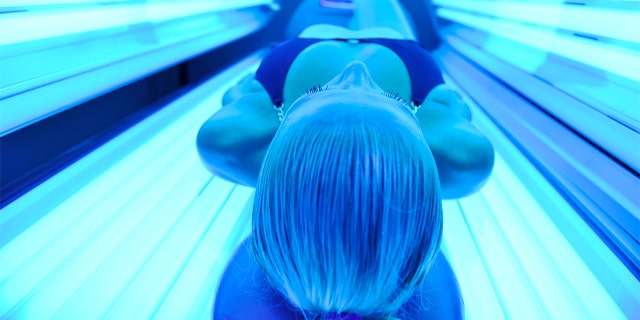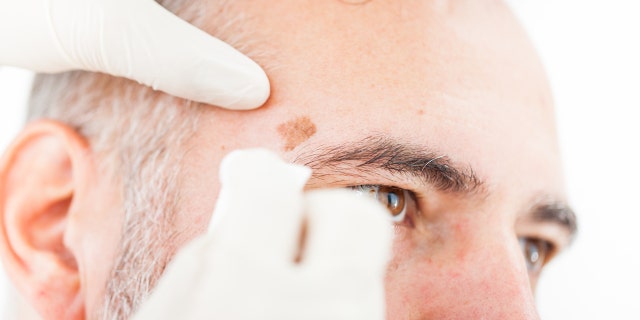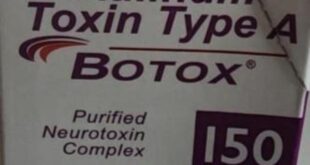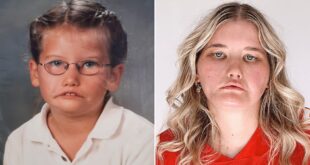
A biopsy performed on a small lesion removed from President Joe Biden’s chest has been confirmed as basal cell carcinoma.
Doctors say that all cancerous tissue was removed and that no further treatment is required.
What exactly is basal cell carcinoma — and what should people know about this common form of skin cancer?
BIDEN HAS ‘CANCEROUS TISSUE’ REMOVED, WHITE HOUSE SAYS: ‘NO FURTHER TREATMENT IS REQUIRED’
Basal cell carcinoma (BCC) is not only the most common type of skin cancer, it’s also the most frequently diagnosed form of all cancers, according to the Skin Cancer Foundation.
Each year, approximately 3.6 million people in the U.S. are diagnosed.

President Joe Biden shields his eyes from the sun as he walks toward Air Force One at Andrews Air Force Base, Maryland, on Oct. 20, 2021. A biopsy performed on a small lesion removed from the president’s chest has been confirmed as basal cell carcinoma. Doctors say all cancerous tissue was removed and that no further treatment is required. (AP Photo/Susan Walsh)
“These cancers form within the skin’s basal cells, which line the deepest part of the epidermis – the outermost layer of the skin,” Dr. Saya Obayan, a board-certified dermatologist practicing in Austin, Texas, and a spokesperson for The Skin Cancer Foundation, told Fox News Digital in a prior interview.
SKIN CANCER CHECKS AND SUNSCREEN: WHY THESE (STILL) MATTER VERY MUCH FOR GOOD HEALTH
“Almost all BCCs occur on parts of the body excessively exposed to the sun, such as the face, ears, neck, scalp, shoulders and back.”
Excessive exposure to ultraviolet radiation — either from the sun or a tanning bed — can cause basal cells to grow at an uncontrolled rate.

Excessive exposure to ultraviolet radiation — either from the sun or a tanning bed — can cause basal cells to grow at an uncontrolled rate. (iStock)
As with all skin cancers, quick detection and action are key.
“Because BCCs grow slowly, most are curable and cause minimal damage when caught early,” said Dr. Obayan.
As with all skin cancers, quick detection and action are key.
BCC is the most common malignancy in White people, said Dr. Marc Siegel, a Fox News medical contributor based in New York City.
It also makes up 80% of non-melanoma skin cancers.
MEN’S SKIN CANCER DEATHS ARE HIGHER THAN WOMEN’S: NEW ANALYSIS
“Overall, it’s easily curable and almost never spreads,” he said.
Important signs
A common warning sign is an open sore that is slow to heal, or that repeatedly heals and comes back.
Other red flags include irritated or red patches of skin; a “shiny bump or nodule” that is clear, pink, red or white in color; or a small pink growth, the Skin Care Foundation states on its website.
Each year, approximately 3.6 million people in the U.S. are diagnosed with basal cell carcinoma.
A more worrisome sign is a “scar-like area that is flat white, yellow or waxy in color,” which may be a sign of a more invasive form of basal cell carcinoma.
Treatments for basal cell carcinoma
“This type of skin cancer is most commonly treated by local surgery, although it can also be removed by creams or radiation,” said Dr. Siegel.

Other treatments for BCC may include topical medications and cryosurgery, where tumors are frozen off with liquid nitrogen. (iStock)
A procedure called Mohs surgery is widely seen as the most effective technique for removing BCC.
First pioneered in the late 1960s and 70s, Mohs has an impressive 99% success rate for curing lesions.
“Mohs surgery works by removing the cancerous cells in layers to preserve healthy tissue,” Dr. Siegel explained.
CLICK HERE TO SIGN UP FOR OUR HEALTH NEWSLETTER
Other treatments for BCC may include topical medications and cryosurgery, where tumors are frozen off with liquid nitrogen, per the Skin Cancer Foundation.
Other common types of skin cancer
The second most common form of skin cancer is squamous cell carcinoma (SCC), which is also caused by UV exposure and mainly affects the same areas as BCC.
“Most SCCs can be easily and successfully treated, but if allowed to grow, they can become disfiguring and even deadly,” Dr. Obayan warned.

Those who notice any skin changes should consult with their doctor. (iStock)
Melanoma is the most dangerous form of skin cancer, and can be deadly if it spreads deeper into the skin or to other parts of the body, the doctor said.
Anyone can get skin cancer — but certain factors increase the risk.
“These include a history of indoor tanning or sunburns, your skin type (the lighter your complexion, the more at risk you are) and genetics,” said Dr. Obayan.
CLICK HERE TO GET THE FOX NEWS APP
The Skin Cancer Foundation has posted photos of each warning sign of basal cell carcinoma on its website.
Those who notice any skin changes should consult their doctor.

 Latest Breaking News Online News Portal
Latest Breaking News Online News Portal




